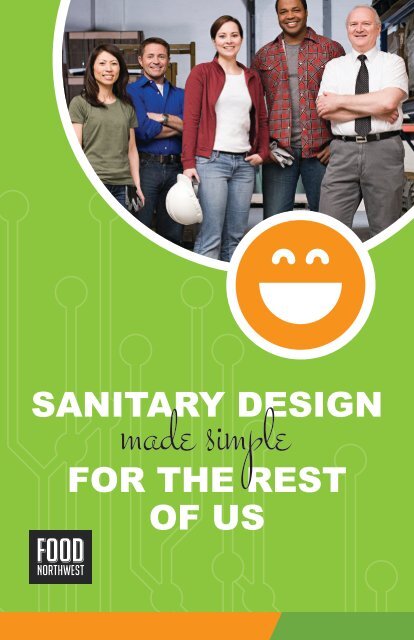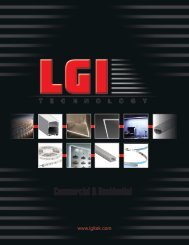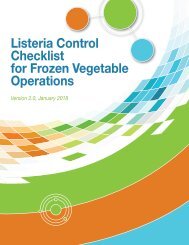Food Northwest - Sanitary Design for the Rest of Us
You also want an ePaper? Increase the reach of your titles
YUMPU automatically turns print PDFs into web optimized ePapers that Google loves.
SANITARY DESIGN<br />
made simple<br />
FOR THE REST<br />
OF US
<strong>Sanitary</strong> <strong>Design</strong><br />
Task Force<br />
John Damon, OFD <strong>Food</strong>s, Chair<br />
Kevin Browning, J.R. Simplot Co.<br />
Dan Freeman, OFD <strong>Food</strong>s<br />
Sam Grubb, Kerr Concentrates<br />
Ron Hall, Ecolab<br />
Justin Lai, FPS Corporation<br />
Debbie Radie, Boardman <strong>Food</strong>s<br />
Melissa Sales, OFD <strong>Food</strong>s<br />
George Sargent, Pacific Seafoods<br />
Rick Stokes, Ecolab<br />
Jamie Wiggins, <strong>Food</strong> <strong>Northwest</strong><br />
Connie Kirby, CLK, LLC<br />
<strong>Food</strong> <strong>Northwest</strong> would like to thank<br />
<strong>the</strong> Oregon Department <strong>of</strong> Agriculture<br />
<strong>for</strong> <strong>the</strong>ir generous support in <strong>the</strong><br />
making <strong>of</strong> this guide.
table <strong>of</strong> contents<br />
What is <strong>Sanitary</strong> <strong>Design</strong> and Why Do I Care?..............................................4<br />
Overview <strong>of</strong> <strong>Sanitary</strong> <strong>Design</strong> <strong>for</strong> Key <strong>Sanitary</strong> <strong>Design</strong> Stakeholders........8<br />
Key <strong>Sanitary</strong> <strong>Design</strong> Checklist......................................................................9<br />
Principle #1: Accessible <strong>for</strong> Inspection, Maintenance, Cleaning,<br />
and Sanitation............................................................................................... 11<br />
Principle #2: No Niches ...............................................................................21<br />
Principle #3: No Collection Points..............................................................29<br />
Principle #4: Eliminate or Minimize Hollow Areas.....................................35<br />
Glossary <strong>of</strong> Terms ........................................................................................42<br />
Where to Go to Learn More .........................................................................43<br />
3
What is <strong>Sanitary</strong> <strong>Design</strong> and Why<br />
Do I Care?<br />
<strong>Sanitary</strong> design in food processing plants refers to when equipment<br />
and <strong>the</strong> facility are constructed so <strong>the</strong>y are easy to clean, meaning<br />
that <strong>the</strong> likelihood <strong>of</strong> producing a safe food product is at its best.<br />
Un<strong>for</strong>tunately, equipment and facilities aren’t always designed that<br />
way. Many facilities and <strong>the</strong>ir equipment were designed be<strong>for</strong>e our<br />
current understanding <strong>of</strong> sanitary design became more widely known.<br />
That’s when hygienic restoration is needed to make changes that<br />
allow <strong>for</strong> better cleaning, sanitizing and inspection. This guide will help<br />
everyone involved with getting and keeping <strong>the</strong> plant clean to be on <strong>the</strong><br />
same page about some basic sanitary design ideas.<br />
Every food processing plant should have written procedures <strong>for</strong><br />
cleaning and sanitizing <strong>the</strong> equipment and facility. This makes sure<br />
everyone knows what to do and how to do it, in addition to meeting<br />
<strong>the</strong> requirements <strong>of</strong> <strong>Food</strong> & Drug Administration (FDA), United States<br />
Department <strong>of</strong> Agriculture (USDA), your local food processing<br />
regulators, and your customers.<br />
That’s because sanitation is one <strong>of</strong> <strong>the</strong> most important lines <strong>of</strong><br />
defense <strong>for</strong> keeping food safe to eat.<br />
How does <strong>the</strong> plan get written?<br />
First, it takes everyone involved – sanitation,<br />
maintenance, production, Quality Assurance<br />
(QA) – putting <strong>the</strong>ir heads toge<strong>the</strong>r, using<br />
<strong>the</strong>ir experience, historical knowledge, and<br />
sanitation records (including microbiological<br />
data), to create a plan.<br />
At <strong>the</strong> same time, whenever a piece <strong>of</strong> equipment is relied on to<br />
prevent cross-contamination <strong>of</strong> <strong>the</strong> final product with pathogens and/or<br />
allergens, you must prove that your sanitation plan actually does get<br />
that equipment free <strong>of</strong> <strong>the</strong>m. This is called validation <strong>of</strong> your plan.
How to validate your sanitation plan:<br />
Break down and clean <strong>the</strong> equipment according to <strong>the</strong> plan.<br />
Call QA to inspect and swab in all <strong>the</strong> ‘hot’ spots where<br />
pathogens or allergens might hide.<br />
Do this several times to see if your plan works every time.<br />
Once you are satisfied that your plan is a good one, QA will want to<br />
test regularly after sanitation and be<strong>for</strong>e start-up to make sure cleaning<br />
and sanitizing procedures are effective. This is when you’ll see <strong>the</strong>m<br />
looking over <strong>the</strong> equipment <strong>for</strong> signs <strong>of</strong> residue (Figure 1). They’ll also<br />
need to take swabs, which <strong>the</strong> laboratory will analyze <strong>for</strong> pathogens or<br />
allergens, because <strong>the</strong>se are not visible to <strong>the</strong> eye.<br />
This is called verification <strong>of</strong> cleaning and sanitizing procedures. It<br />
needs to be done according to <strong>the</strong> frequecy outlined in your <strong>Food</strong><br />
Safety Plan.<br />
Some reasons why <strong>the</strong>y wouldn’t be cleaned and sanitized are:<br />
• New personnel might need more training and experience to do<br />
<strong>the</strong> job right.<br />
• Wear, damage, or modifications have made <strong>the</strong> ability to clean<br />
<strong>the</strong> equipment challenging.<br />
Figure 1<br />
QA inspector doing visual pre-operative inspection <strong>for</strong> residue and swabbing<br />
<strong>for</strong> pathogens.<br />
5
Sometimes, after production has run <strong>for</strong> a while, pathogens that were<br />
hiding can break free and contaminate <strong>the</strong> food. QA will also want to<br />
take swabs <strong>for</strong> testing during <strong>the</strong>se times too (Figure 2). This will give<br />
additional important in<strong>for</strong>mation about how well <strong>the</strong> equipment was<br />
cleaned and sanitized to begin with.<br />
Figure 2<br />
Production<br />
swabs being<br />
taken to detect<br />
pathogens that<br />
have broken<br />
free from<br />
niches during<br />
processing.<br />
How do Sanitation and <strong>Sanitary</strong> <strong>Design</strong> Go Toge<strong>the</strong>r?<br />
When equipment and facilities are designed with sanitation in mind, <strong>the</strong><br />
sanitation crew can do <strong>the</strong>ir job better, with less ef<strong>for</strong>t, and in less time.<br />
This means <strong>the</strong>re is less opportunity <strong>for</strong> contamination <strong>of</strong> food with<br />
pathogens or allergens.<br />
That’s where this guide comes in.<br />
We aren’t trying to cover <strong>the</strong> whole subject <strong>of</strong> how to engineer sanitary<br />
design. There are lots <strong>of</strong> standards that help do that.<br />
This guide is meant to help sanitation and food plant workers who are<br />
working with equipment and in facilities every day to understand <strong>the</strong><br />
most important sanitary design problems and solutions. Those are <strong>the</strong><br />
people who know <strong>the</strong> equipment and <strong>the</strong> plant <strong>the</strong> best. They can <strong>of</strong>ten<br />
come up with some <strong>of</strong> <strong>the</strong> best solutions to problems in existing plants,<br />
or provide some <strong>of</strong> <strong>the</strong> best advice when buying new equipment or<br />
building new facilities.
Is it <strong>Design</strong>ed with<br />
Sanitation in Mind?<br />
Here’s some questions to ask yourself to help<br />
you look at equipment and facilities in a new<br />
sanitary design way.<br />
<br />
Would you lick it?<br />
Is it really clean? Even after <strong>the</strong> best cleaning,<br />
if <strong>the</strong> answer to <strong>the</strong> question is still no, <strong>the</strong>re<br />
is a good chance that <strong>the</strong> equipment isn’t<br />
designed effectively to properly clean it.<br />
<br />
Could it ooze out?<br />
If, over time, product could ooze, flow, fall or<br />
“juice” out due to agitation, vibration, or gravity,<br />
<strong>the</strong>n <strong>the</strong>re is opportunity <strong>for</strong> improvement<br />
on that equipment. Product and/or moisture<br />
accumulation can lead to cross contamination<br />
and unsafe product.<br />
<br />
Where would I hide to survive?<br />
To answer this question, you must think like a<br />
bacterium. If I am microscopic, where can I<br />
go on this equipment to not be destroyed by<br />
cleaning and sanitation and still have access<br />
to water and food?<br />
7
Overview <strong>of</strong> <strong>Sanitary</strong> <strong>Design</strong> <strong>for</strong> Key<br />
<strong>Sanitary</strong> <strong>Design</strong> Stakeholders<br />
The purpose <strong>of</strong> this section is to provide a quick reference <strong>for</strong> food<br />
workers, sanitation workers, maintenance staff, and any o<strong>the</strong>r<br />
interested persons, to assess some <strong>of</strong> <strong>the</strong> most important attributes<br />
<strong>of</strong> sanitary design <strong>of</strong> food processing equipment. This guide provides<br />
a visual reference to quickly identify some <strong>of</strong> <strong>the</strong> most commonly<br />
discovered sanitary design flaws that have been associated with food<br />
production equipment.<br />
The objective is to help <strong>the</strong>se people:<br />
• Spot improvements that will have <strong>the</strong> most impact on improving<br />
sanitation in existing Zone 1 and 2 equipment and facilities, or;<br />
• Talk to suppliers about expectations or good sanitary design, when<br />
evaluating <strong>for</strong> purchase, new equipment <strong>for</strong> Zones 1 and 2 that will<br />
be easily and effectively cleaned.<br />
This guide is not meant to be comprehensive or in-depth treatment <strong>of</strong><br />
sanitary design. Extensive sanitary design checklists and in-depth<br />
training are available separately (See page 43 <strong>for</strong> resources).<br />
<strong>Us</strong>e <strong>the</strong> checklist on <strong>the</strong> next page to ensure all key sanitary design<br />
areas are addressed.<br />
<strong>Us</strong>e <strong>the</strong> Principle chapters that follow <strong>for</strong> a visual reference and more<br />
detail around each <strong>of</strong> <strong>the</strong> key sanitary design principles.
Key <strong>Sanitary</strong> <strong>Design</strong> Checklist<br />
Principle #1: Accessible <strong>for</strong> Inspection, Maintenance,<br />
Cleaning, and Sanitation<br />
All surfaces are accessible <strong>for</strong> mechanical cleaning<br />
and treatment to prevent bi<strong>of</strong>ilms <strong>for</strong>mation.<br />
All surfaces are easy to see.<br />
Equipment is easy to disassemble <strong>for</strong> cleaning<br />
and inspection without <strong>the</strong> use <strong>of</strong> tools.<br />
Pay special attention to:<br />
Exposed wiring near food contact surfaces;<br />
Product hoppers and gates;<br />
Conveyor belts and surrounding areas including<br />
catch pans, belt scrapers, and rotators that direct<br />
product along <strong>the</strong> line;<br />
Access doors;<br />
Chain guards;<br />
Piping.<br />
Principle #2: No Niches<br />
Free <strong>of</strong>:<br />
Pits;<br />
Cracks;<br />
Corrosion;<br />
Recesses;<br />
Open seams;<br />
Protruding ledges;<br />
Inside threads;<br />
Bolts;<br />
Rivets;<br />
Bunched wires;<br />
Dead ends.<br />
9
Principle #3: No Collection Points<br />
All surfaces should be designed to be self-draining<br />
and prevent pooling.<br />
Horizontal members on equipment should be rounded or angled<br />
to prevent buildup <strong>of</strong> liquid or product.<br />
Surfaces are made <strong>of</strong> non-absorbent material.<br />
Surfaces are made <strong>of</strong> material that won’t warp over time and<br />
create collection points.<br />
Moisture does not drip, drain, or draw into product areas.<br />
Conveyor belts are tense enough to prevent collection or pooling.<br />
Dead spaces where product or liquid can collect <strong>of</strong> time<br />
are eliminated.<br />
Principle #4: Eliminate or Minimize Hollow Areas<br />
Hollow areas are hermetically sealed wherever possible.<br />
In Zone 1, eliminate:<br />
Tubes;<br />
Drilled or taped holes;<br />
Partially welded seams;<br />
Bolts;<br />
Studs;<br />
Mounting plates;<br />
Junction boxes;<br />
Brackets;<br />
Plates;<br />
End caps;<br />
Sleeves;<br />
Hinges.
Principle #1: Accessible <strong>for</strong> Inspection,<br />
Maintenance, Cleaning, and Sanitation<br />
Areas <strong>of</strong> equipment where product is going to be present should be<br />
easy to see and need no tools <strong>for</strong> disassembly. This facilitates<br />
maintenance, cleaning and sanitation and makes it so <strong>the</strong> equipment<br />
can be inspected be<strong>for</strong>e running product over it.<br />
Some <strong>of</strong> <strong>the</strong> key problem areas we’ll cover include:<br />
• Exposed wiring near food contact surfaces<br />
• Product hoppers and gates<br />
• Conveyor belts and surrounding areas including catch pans, belt<br />
scrapers, and rotators that direct product along <strong>the</strong> line<br />
• Access doors<br />
• Chain guards<br />
• Piping<br />
11
Exposed Wiring Near <strong>Food</strong> Contact Surfaces<br />
Poor <strong>Design</strong><br />
Figure 3 shows a neatly bundled collection <strong>of</strong> wires. The problem is that<br />
it is next to a belt where product is exposed. <strong>Food</strong> and debris can<br />
collect on and between <strong>the</strong> wires, but <strong>the</strong> wires cannot be easily<br />
disassembled <strong>for</strong> cleaning. This creates a great place <strong>for</strong> pathogens to<br />
build permanent homes, or niches, and contaminate <strong>the</strong> product that<br />
goes by during production.<br />
Figure 3<br />
<strong>Food</strong> debris<br />
collects<br />
between <strong>the</strong><br />
bundled wires<br />
and <strong>the</strong>y<br />
can’t be<br />
disassembled<br />
<strong>for</strong> cleaning.<br />
Figure 4<br />
Metal conduit<br />
with signs <strong>of</strong><br />
water having<br />
gotten inside,<br />
creating<br />
potential<br />
harborage<br />
point <strong>for</strong><br />
pathogens.
Poor <strong>Design</strong><br />
Conduit <strong>for</strong> wires can present problems, especially at joints and access<br />
points. Figure 4 shows where water has obviously entered into <strong>the</strong><br />
metal conduit joint and rusted. The interior <strong>of</strong> this joint and conduit<br />
cannot be accessed <strong>for</strong> cleaning and inspection. This creates a<br />
potential harborage point <strong>for</strong> pathogens.<br />
Poor <strong>Design</strong><br />
The cables in Figure 5 are banded toge<strong>the</strong>r with plastic zip ties. They<br />
have collected food debris and cannot be cleaned and inspected<br />
while bundled. The ties could be cut and replaced after cleaning and<br />
inspection but this time-consuming job is unlikely during regular<br />
sanitation shifts.<br />
Figure 5<br />
Cables banded<br />
toge<strong>the</strong>r such<br />
that <strong>the</strong>y<br />
cannot be<br />
cleaned - note<br />
food debris.<br />
A worried <strong>Sanitary</strong> <strong>Design</strong> Man sees several opportunities<br />
<strong>for</strong> hygienic restoration here. Can you help him<br />
point out what else is wrong with this picture?<br />
13
Better <strong>Design</strong><br />
Wires can be “hung” along equipment framework by D-rings, as in<br />
Figure 6, that allow <strong>for</strong> easy access or contained in a wire chase that<br />
allows ease <strong>of</strong> cleaning (where multiple wires/cables are involved –<br />
each individual wire must be able to be separated from <strong>the</strong> o<strong>the</strong>rs).<br />
Figure 6<br />
D-ring allows<br />
cables to not<br />
be banded<br />
toge<strong>the</strong>r so<br />
<strong>the</strong>y can be<br />
moved,<br />
separated, and<br />
cleaned, but<br />
contains poor<br />
welds.<br />
Best <strong>Design</strong><br />
Figure 7<br />
D-ring holds<br />
cables, allows<br />
<strong>for</strong> cleaning,<br />
and contains<br />
smooth welds.
Product Hoppers<br />
Poor <strong>Design</strong><br />
Hoppers and gates <strong>of</strong>fer challenges in sanitary design. Inaccessible<br />
surfaces, like <strong>the</strong> interior <strong>of</strong> <strong>the</strong> flange joints in Figure 8, are not easily<br />
disassembled without tools, as <strong>the</strong> bolts in this example. There are<br />
several catch points <strong>for</strong> soil that cannot be disassembled and are not<br />
accessible <strong>for</strong> cleaning or inspection.<br />
Figure 8<br />
Hopper<br />
sections that<br />
cannot be<br />
cleaned without<br />
taking apart.<br />
Poor <strong>Design</strong><br />
In Fig. 9, <strong>the</strong> equipment is designed with a flexible hose laying over <strong>the</strong><br />
hopper with exposed product. Due to <strong>the</strong> indentations that give <strong>the</strong><br />
hose its flexibility, it is difficult to clean and will be a potential harborage<br />
point <strong>for</strong> pathogens.<br />
15
Poor <strong>Design</strong><br />
Figure 9<br />
New sorter<br />
with hose made<br />
<strong>of</strong> difficult to<br />
clean material,<br />
located over a<br />
product hopper.<br />
A worried <strong>Sanitary</strong> <strong>Design</strong> Man sees several opportunities<br />
<strong>for</strong> hygienic restoration here. Can you help him<br />
point out what else is wrong with this picture?<br />
Better <strong>Design</strong><br />
Figure 10 shows a better hopper design because <strong>the</strong>re are spacers to<br />
allow cleaning between <strong>the</strong>m. However, <strong>the</strong> spacers are not easily<br />
removed <strong>for</strong> cleaning and can become a harborage point <strong>the</strong>mselves.<br />
Figure 10<br />
Better access<br />
<strong>for</strong> cleaning and<br />
inspections,<br />
however,<br />
spacers are<br />
bolted and<br />
not easily<br />
disassembled.
In hoppers <strong>of</strong> good design, sections that are not welded should<br />
be designed <strong>for</strong> easy disassembly without tools or redesigned <strong>for</strong><br />
accessibility, as in Figures 11, 12 and 13.<br />
Best <strong>Design</strong><br />
Figure 11<br />
Open-easy<br />
access <strong>for</strong><br />
inspection<br />
and cleaning.<br />
Figure 12<br />
Pinned instead<br />
<strong>of</strong> bolted<br />
<strong>for</strong> easy<br />
disassembly<br />
and cleaning.<br />
17
Best <strong>Design</strong><br />
The shaker hopper in Figure 13 can be fully disassembled without tools<br />
<strong>for</strong> cleaning and inspection.<br />
Figure 13<br />
Shaker hopper<br />
is easily<br />
dissasembled<br />
and accessable<br />
<strong>for</strong> cleaning.<br />
Conveyor Belts and Surrounding Equipment<br />
Poor <strong>Design</strong><br />
The belt in Figure 14 is joined by metal rods that are difficult to disassemble<br />
making it impossible to access <strong>for</strong> cleaning and inspection. The<br />
thousands <strong>of</strong> small holes that thread <strong>the</strong> rods are harborage points <strong>for</strong><br />
pathogens and will contaminate <strong>the</strong> product that moves over it.<br />
Figure 14<br />
Belt hinges<br />
difficult to<br />
disassemble<br />
and clean.
A worried <strong>Sanitary</strong> <strong>Design</strong> Man sees several opportunities<br />
<strong>for</strong> hygienic restoration here. Can you help him<br />
point out what else is wrong with Figure 14?<br />
Better <strong>Design</strong><br />
Scrapers and side rails on conveyor belts should be removable or<br />
designed so that <strong>the</strong>y may be rotated away from <strong>the</strong> conveyer or<br />
head/tail roll <strong>for</strong> cleaning as in Figure 17. They should be installed<br />
underneath <strong>the</strong> conveyer where possible. Scrapers should be designed<br />
<strong>of</strong> one solid material with a minimum <strong>of</strong> penetrations (scraper should<br />
not have screws or bolts exposed to <strong>the</strong> food contact side <strong>of</strong> <strong>the</strong><br />
scraper). If made <strong>of</strong> multiple materials <strong>the</strong> scraper should be easily<br />
dissembled <strong>for</strong> cleaning and sanitation.<br />
The mechanism <strong>for</strong> <strong>the</strong> shaker conveyor in Figure 15 is mounted to <strong>the</strong><br />
bottom flange <strong>of</strong> <strong>the</strong> belt and not exposed to <strong>the</strong> <strong>Food</strong> Contact Surface<br />
(FCS). In addition, <strong>the</strong> belt surface itself is solid, so no disassembly is<br />
required to clean and inspect this belt.<br />
Figure 15<br />
Note that<br />
this shaker<br />
conveyor does<br />
not have<br />
penetrations<br />
(bolts have<br />
been removed)<br />
on stainless<br />
steel food<br />
contact<br />
surfaces.<br />
19
Best <strong>Design</strong><br />
The conveyor belt in Fig. 16 rides on solid stainless-steel supports. To<br />
clean, <strong>the</strong> tension rods on <strong>the</strong> support system are loosened and <strong>the</strong> belt<br />
is accessible <strong>for</strong> cleaning and inspection be<strong>for</strong>e reassembly. Also,<br />
notice that <strong>the</strong> belt is composed <strong>of</strong> one solid piece <strong>of</strong> material, leaving<br />
no places <strong>for</strong> niches, as in Fig.14.<br />
Figure 16<br />
Conveyer rides<br />
on stainless<br />
supports - note<br />
removable<br />
stainless<br />
scraper.<br />
Figure 17<br />
Side guide<br />
made <strong>of</strong><br />
stainless steel<br />
(no UHMW)<br />
that swings<br />
away.
Principle #2: No Niches<br />
Equipment in Zones 1 and 2 should be free <strong>of</strong> pits, cracks, corrosion,<br />
recesses, open seams, gaps, lap seams, protruding ledges, inside<br />
threads, bolts, rivets, bunched wires, and dead ends. Any <strong>of</strong> <strong>the</strong>se<br />
can create protected areas where bacteria can hide and live. Once<br />
established, no routine amount <strong>of</strong> scrubbing or chemicals will eliminate<br />
<strong>the</strong>ir colonies. The only solution is correcting <strong>the</strong> defect and taking<br />
extraordinary measures to kill <strong>the</strong> bacteria lodged <strong>the</strong>re.<br />
21
Niches and Harbor Points<br />
Figure 18a shows high hygiene risk finishes <strong>for</strong> edges on <strong>the</strong> left that<br />
can potentially trap pathogens and create niches that will contaminate<br />
product. By contrast, acceptable edge finishes on <strong>the</strong> right in Figure<br />
18b can be more easily cleaned.<br />
Figure 18a<br />
Hygiene risk<br />
<strong>for</strong> edge<br />
finishes.<br />
Figure 18b<br />
Acceptable<br />
risk alternatives<br />
<strong>for</strong> edge<br />
finishes.<br />
Poor <strong>Design</strong><br />
Figure 19 has recessed bolts, lapped seams, square corners, etc.<br />
Product is accumulating in this area and <strong>the</strong>re are many opportunities<br />
<strong>for</strong> niches to <strong>for</strong>m and become a product contamination problem.<br />
Figure 19<br />
Belt assembly<br />
showing<br />
recessed bolts,<br />
o<strong>the</strong>r potential<br />
niche areas.
A worried <strong>Sanitary</strong> <strong>Design</strong> Man sees several opportunities<br />
<strong>for</strong> hygienic restoration here. Can you help him<br />
point out what else is wrong with Figure 19?<br />
Best <strong>Design</strong><br />
The gate assembly in Figure 20 was originally bolted as one piece onto<br />
<strong>the</strong> hopper wall. It was redesigned to be removable by use <strong>of</strong> wing<br />
nuts. The flexible gate is easily disassembled by slipping <strong>the</strong> pins from<br />
<strong>the</strong>ir slots.<br />
Figure 20<br />
Product gate<br />
with fasteners<br />
removed,<br />
designed to<br />
be easily<br />
cleanable.<br />
23
Poor <strong>Design</strong><br />
The hopper in Figure 21 has stickers applied to <strong>the</strong> outside to<br />
communicate important in<strong>for</strong>mation about use <strong>of</strong> <strong>the</strong> equipment.<br />
However, stickers peel over time and potentially introduce <strong>for</strong>eign<br />
material into <strong>the</strong> product, as well as provide places where niches can<br />
harbor harmful bacteria.<br />
Figure 21<br />
Stickers<br />
create<br />
uncleanable<br />
niches on<br />
equipment<br />
surfaces.<br />
A worried <strong>Sanitary</strong> <strong>Design</strong> Man sees several opportunities<br />
<strong>for</strong> hygienic restoration here. Can you help him<br />
point out what else is wrong with this picture?<br />
Better <strong>Design</strong><br />
The signage in Figure 22 eliminates <strong>the</strong> need <strong>for</strong> stickers and can be<br />
cleaned underneath because <strong>of</strong> <strong>the</strong> spacing. However, <strong>the</strong> paint on <strong>the</strong><br />
sign can chip over time and create <strong>for</strong>eign material problems as well<br />
as niches where <strong>the</strong> rough edge <strong>of</strong> <strong>the</strong> paint is exposed. In addition,<br />
<strong>the</strong> sign is riveted to <strong>the</strong> equipment and cannot be disassembled<br />
<strong>for</strong> cleaning. Ano<strong>the</strong>r option would be laser etching. However, laser<br />
etching must be done with care to minimize any niches in <strong>the</strong> grooves<br />
<strong>of</strong> <strong>the</strong> etching.
Figure 22<br />
Offset sign<br />
eliminates <strong>the</strong><br />
need <strong>for</strong><br />
stickers, but<br />
chipping paint<br />
and attachment<br />
site can<br />
cause niches.<br />
Best <strong>Design</strong><br />
The best option to signage, would be to not use any on food processing<br />
equipment. When stickers are neccessary, <strong>the</strong>y should be easily<br />
removable and placed away from food contact surfaces.<br />
Poor <strong>Design</strong><br />
The mixer in Figure 23 has flat cross-members on <strong>the</strong> legs and flat<br />
flanges <strong>for</strong> anchoring. Both <strong>of</strong> <strong>the</strong>se can accumulate product and liquid<br />
and <strong>for</strong>m harborage sites <strong>for</strong> bacteria.<br />
Figure 23<br />
Flat horizontal<br />
surfaces on<br />
cross-members<br />
and feet create<br />
niche points.<br />
25
Better <strong>Design</strong><br />
The cross-members in Figure 24 are angled so that material can slide<br />
<strong>of</strong>f and not accumulate <strong>the</strong>re. The smooth weld prevents niches from<br />
<strong>for</strong>ming on a rough surface. The legs are not bolted to <strong>the</strong> floor and can<br />
be moved <strong>for</strong> cleaning.<br />
Figure 24<br />
Angled<br />
cross-member<br />
on legs and<br />
smooth weld<br />
prevent<br />
accumulation <strong>of</strong><br />
product, niche<br />
<strong>for</strong>mation.<br />
Best <strong>Design</strong><br />
The top <strong>of</strong> <strong>the</strong> cabinet in Figure 25 is sloped to prevent buildup <strong>of</strong><br />
product and liquid from collecting on <strong>the</strong> surface.<br />
Figure 25<br />
The top <strong>of</strong><br />
this cabinet<br />
is sloped to<br />
prevent<br />
accumulation<br />
<strong>of</strong> product<br />
and liquid.
Hinges<br />
Poor <strong>Design</strong><br />
Hinges and door clamps can create harborage points if <strong>the</strong>y are not<br />
designed <strong>for</strong> easy disassembly. The piano hinge in Figure 26 is a good<br />
example. Each one <strong>of</strong> <strong>the</strong> pin loops allows entry <strong>of</strong> water and cannot<br />
easily be accessed <strong>for</strong> cleaning.<br />
Figure 26<br />
The piano<br />
hinge on this<br />
control box<br />
cannot be<br />
cleaned.<br />
Better <strong>Design</strong><br />
Clamps can be used instead <strong>of</strong> hinges that run <strong>the</strong> length <strong>of</strong> <strong>the</strong><br />
equipment, which reduces <strong>the</strong> number <strong>of</strong> niche points and allows <strong>for</strong><br />
easier cleaning.<br />
Figure 27<br />
The external<br />
door clamps<br />
cannot be<br />
disassembled<br />
<strong>for</strong> cleaning.<br />
27
Better <strong>Design</strong><br />
Figure 28<br />
Hinges shielded<br />
to help prevent<br />
water entry,<br />
and is <strong>of</strong>fset<br />
from floor<br />
and wall.<br />
However,<br />
hinges can<br />
still be niche<br />
points.<br />
Best <strong>Design</strong><br />
Figure 29<br />
¼ turn latch<br />
is more<br />
cleanable and<br />
creates less<br />
harborage<br />
space.
Principle #3: No Collection Points<br />
All surfaces <strong>of</strong> equipment should be designed to prevent pooling <strong>of</strong><br />
water and be self-draining. Think about where water accumulates,<br />
pools or condenses alone or with product. Never use absorbent materials<br />
on equipment.<br />
Moisture should never drip, drain, or draw into product areas. Conveyor<br />
belts should be tense enough to prevent pooling. Eliminate dead<br />
spaces where water and/or product can accumulate over <strong>the</strong> course<br />
<strong>of</strong> <strong>the</strong> shift.<br />
29
Drip Pans<br />
Poor <strong>Design</strong><br />
The drip pan in Figure 30 is designed to catch fluids from <strong>the</strong><br />
connections or motor above it. However, it is more likely to be an<br />
opportunity <strong>for</strong> water and/or product to accumulate and create a<br />
product contamination hazard.<br />
Figure 30<br />
Drip pan<br />
collects water<br />
and/or product.<br />
Poor <strong>Design</strong><br />
There is a lip along <strong>the</strong> bottom <strong>of</strong> <strong>the</strong> hopper in Figure 31. It’s unclear<br />
why it is <strong>the</strong>re, maybe to give strength to a long stretch <strong>of</strong> stainless<br />
steel. Perhaps it was designed to catch condensation, although <strong>the</strong><br />
acute angle <strong>of</strong> <strong>the</strong> lip limits <strong>the</strong> amount <strong>of</strong> condensation be<strong>for</strong>e it<br />
overflows and <strong>the</strong>re is no drainage point. If <strong>the</strong> outside <strong>of</strong> <strong>the</strong> hopper is<br />
clean, <strong>the</strong>n <strong>the</strong> condensate collecting <strong>the</strong>re will most likely also<br />
be clean. However, if food collects <strong>the</strong>re as well, <strong>the</strong> opportunity <strong>for</strong><br />
pathogens to collect and grow is a potential.
Figure 31<br />
Condensate on<br />
<strong>the</strong> outside <strong>of</strong> a<br />
hopper will be<br />
caught by this<br />
lip. If food<br />
debris gets<br />
into this area,<br />
it can result<br />
in microbial<br />
harborage.<br />
Better <strong>Design</strong><br />
Drip pans should be designed to catch fluids, but direct it away from<br />
product and prevent accumulation. Flat surfaces and lips should be<br />
avoided.<br />
Figure 32<br />
Drip pan<br />
removed<br />
from under<br />
motor housing<br />
to prevent<br />
water<br />
accumulation.<br />
However,<br />
without <strong>the</strong><br />
drip pan <strong>the</strong>re<br />
is no direction<br />
<strong>of</strong> drippings,<br />
which can<br />
lead to<br />
contamination.<br />
31
Best <strong>Design</strong><br />
Figure 33<br />
Catch pan is<br />
inclined so<br />
<strong>the</strong>re is no<br />
accumulation.<br />
Moisture is<br />
directed away<br />
from <strong>the</strong><br />
product.<br />
Drains<br />
The trench drains in Figure 34 have plastic inserts, pits and cracks, and<br />
gaps. They provide multiple locations <strong>for</strong> moisture accumulation and<br />
are nearly impossible to clean adequately.<br />
Figure 34<br />
Trench drains<br />
with many<br />
opportunities<br />
<strong>for</strong> moisture<br />
accumulation.<br />
A worried <strong>Sanitary</strong> <strong>Design</strong> Man sees several opportunities<br />
<strong>for</strong> hygienic restoration here. Can you help him<br />
point out what else is wrong with this picture?
Better <strong>Design</strong><br />
Trench drains in Figure 35 are redesigned with a stainless steel lining<br />
that is smooth and cleanable and reduces <strong>the</strong> potential <strong>for</strong> water<br />
accumulation.<br />
Figure 35<br />
Trench drains<br />
with stainless<br />
steel lining<br />
reduces water<br />
accumulation,<br />
makes <strong>for</strong><br />
easier cleaning.<br />
Best <strong>Design</strong><br />
An even better design is to convert to stainless steel circular drains<br />
like that in Figure 36. Sloping <strong>of</strong> floors toward <strong>the</strong> drain guides waste<br />
water away to prevent pooling on <strong>the</strong> floor. These drains are smooth,<br />
cleanable surfaces.<br />
Figure 36<br />
Stainless steel<br />
circular drain<br />
is better<br />
alternative to<br />
trench drains.<br />
33
Dead Spots or Product Collection Points<br />
The drain table in Figure 37 shows signs <strong>of</strong> rust where water collection<br />
has occurred. This standing water can recontaminate <strong>the</strong> equipment<br />
that is stored here.<br />
A worried <strong>Sanitary</strong> <strong>Design</strong> Man sees several opportunities<br />
<strong>for</strong> hygienic restoration here. Can you help him<br />
point out what else is wrong with this picture?<br />
Figure 37<br />
Sanitation drain<br />
table has a dead<br />
spot which<br />
allows collection<br />
<strong>of</strong> product<br />
and moisture,<br />
and has led<br />
to corrosion.<br />
This could<br />
re-contaminate<br />
clean equipment.<br />
Best <strong>Design</strong><br />
Figure 38<br />
Sanitation table<br />
has stainless<br />
steel per<strong>for</strong>ated<br />
insert, is in<br />
good condition<br />
and is easily<br />
removed <strong>for</strong><br />
effective<br />
cleaning.
Principle #4: Eliminate or Minimize Hollow Areas<br />
Hollow areas should be hermetically sealed, wherever possible, to<br />
prevent water and food entry. The internal spaces <strong>of</strong> hollow areas are<br />
not accessible <strong>for</strong> cleaning and inspection which provides a harborage<br />
point <strong>for</strong> pathogens. There should be no tubes, drilled or taped holes,<br />
or partially welded seams on any equipment in areas where product<br />
is exposed. Bolts, studs, mounting plates, brackets, junction boxes,<br />
plates, end caps, sleeves, and hinges.<br />
35
Poor <strong>Design</strong><br />
Figure 39 illustrates a poorly designed packing table where telescoping<br />
legs were installed. The legs are hollow to accommodate <strong>the</strong> leg jack<br />
inside – a tube in tube construction. Where <strong>the</strong> jack exits <strong>the</strong> leg to<br />
allow <strong>for</strong> adjustment, water can enter <strong>the</strong> threaded holes. Nei<strong>the</strong>r <strong>the</strong><br />
interior surface <strong>of</strong> <strong>the</strong> leg or <strong>the</strong> jack can be accessed <strong>for</strong> cleaning<br />
and inspection without dismantling each leg, a time-consuming task<br />
unlikely to get done in a sanitation shift.<br />
Figure 39<br />
Telescoping<br />
legs create<br />
hollow<br />
cavities - tube<br />
in tube<br />
construction is<br />
difficult to clean<br />
and inspect.<br />
Best <strong>Design</strong><br />
The telescoping legs in Figure 39 were replaced with sealed-tube legs<br />
welded to <strong>the</strong> packing table, as shown in Figure 40. There is no need<br />
<strong>for</strong> disassembly and <strong>the</strong>y are easily cleanable.<br />
Figure 40<br />
Packing table<br />
with telescoping<br />
legs replaced<br />
by seal welded<br />
tube legs.
Poor <strong>Design</strong><br />
The product funnel in Figure 41 has numerous clamps, fasteners, and<br />
plastic pieces over product creating a potential <strong>for</strong>eign material<br />
contamination problem. In addition, <strong>the</strong> complicated disassembly<br />
<strong>of</strong> <strong>the</strong> funnel mechanism prohibits thorough and effective cleaning<br />
and inspection.<br />
Figure 41<br />
Numerous<br />
small parts over<br />
<strong>the</strong> product<br />
requires<br />
extensive<br />
disassembly.<br />
Best <strong>Design</strong><br />
Figure 42<br />
On <strong>the</strong> left, pins,<br />
plastic clamps,<br />
and fasteners<br />
have been<br />
removed from<br />
this product<br />
funnel. It is held<br />
in place with<br />
magnets only.<br />
On <strong>the</strong> right, it<br />
is lifted <strong>of</strong>f <strong>the</strong><br />
frame and<br />
removed <strong>for</strong><br />
easy cleaning.<br />
37
Poor <strong>Design</strong><br />
The product pole in Figure 43 is uncleanable due to <strong>the</strong> hollow<br />
interior surface.<br />
Figure 43<br />
Hollow tubes<br />
<strong>of</strong> such narrow<br />
diameter<br />
are not<br />
cleanable on<br />
<strong>the</strong>ir interior<br />
surface.<br />
A worried <strong>Sanitary</strong> <strong>Design</strong> Man sees several opportunities<br />
<strong>for</strong> hygienic restoration here. Can you help him<br />
point out what else is wrong with this picture?<br />
Improved <strong>Design</strong><br />
Figure 44<br />
Hollow tubes<br />
have been<br />
capped with<br />
continuous<br />
weld.<br />
Sealed tube<br />
is easily<br />
cleanable.
Augers<br />
Poor <strong>Design</strong><br />
Figure 45 shows <strong>the</strong> auger filler as supplied by <strong>the</strong> equipment manufacturer.<br />
The open product hopper is difficult to separate from <strong>the</strong> frame<br />
<strong>for</strong> cleaning because <strong>of</strong> <strong>the</strong> fasteners around <strong>the</strong> rim.<br />
Figure 45<br />
Hopper cover<br />
is not easily<br />
disassembled<br />
<strong>for</strong> cleaning<br />
and inspection.<br />
A worried <strong>Sanitary</strong> <strong>Design</strong> Man sees several opportunities<br />
<strong>for</strong> hygienic restoration here. Can you help him<br />
point out what else is wrong with this picture?<br />
39
Best <strong>Design</strong><br />
Figure 46 is <strong>the</strong> same type <strong>of</strong> hopper, but <strong>the</strong> fasteners have been<br />
removed. Clamps and gravity are relied upon to hold equipment<br />
in place.<br />
Figure 46<br />
Hopper cover<br />
fasteners<br />
removed,<br />
replaced with<br />
clamps that<br />
set in place.<br />
Poor <strong>Design</strong><br />
The auger drive mechanism in Figure 47 was difficult to clean and <strong>the</strong><br />
grease might be able to get into <strong>the</strong> product. The processor redesigned<br />
<strong>the</strong> drive to separate <strong>the</strong> bearings from <strong>the</strong> product, making it much<br />
easier to clean and removing potential <strong>for</strong> grease to contaminate<br />
<strong>the</strong> product.<br />
Figure 47<br />
Difficult to<br />
clean and<br />
leakage can<br />
occur in<br />
<strong>the</strong> product.
Better <strong>Design</strong><br />
Figure 48<br />
Bearing<br />
separated<br />
from<br />
product-more<br />
cleanable.<br />
Holes<br />
Holes drilled into equipment should be avoided when possible. Holes<br />
create hollow areas that can be difficult to clean and possibly create<br />
harborages. If holes can’t be avoided <strong>the</strong>n <strong>the</strong>y should have smooth<br />
internal surfaces free from threads and rough welds, as seen below<br />
in Figure 49.<br />
Figure 49<br />
Poor design <strong>of</strong><br />
a hole that<br />
contains threads<br />
-improved<br />
design with<br />
hole that is<br />
smooth inside.<br />
Best design<br />
contains no<br />
holes and avoids<br />
potential harbor<br />
spots.<br />
41
glossary <strong>of</strong> terms<br />
FCS: <strong>Food</strong> Contact Surface - a site on equipment where food product<br />
makes direct contact with <strong>the</strong> equipment.<br />
<strong>Food</strong> Safety Plan (FSP): A document, required by <strong>the</strong> <strong>Food</strong> Safety<br />
and Modernization Act, which contains all identified food safety<br />
hazards and <strong>the</strong> preventative activities in place to control <strong>the</strong>m. It<br />
contains all documents that outline <strong>the</strong> safety practices <strong>for</strong> food during<br />
manufacturing, processing, packing and holding.<br />
Harborage: a site on food processing equipment that is difficult to<br />
access <strong>for</strong> cleaning and can support bacterial survival and growth.<br />
Hygienic <strong>Rest</strong>oration: <strong>the</strong> process <strong>of</strong> redesigning and improving<br />
existing equipment to better protect against <strong>the</strong> harborage and growth<br />
<strong>of</strong> bacteria in <strong>the</strong> food processing facility.<br />
Niche: a pit, recess, crack, gap or o<strong>the</strong>r site on equipment where<br />
bacteria can hide and survive.<br />
<strong>Sanitary</strong> <strong>Design</strong>: <strong>the</strong> design, manufacture and installation <strong>of</strong> facilities<br />
and equipment to reduce <strong>the</strong> risks <strong>of</strong> bacterial contamination <strong>of</strong> food.<br />
Validation: <strong>the</strong> process <strong>of</strong> confirming that a cleaning and sanitation<br />
plan works by collecting and analyzing swabs <strong>for</strong> harmful (pathogenic)<br />
bacteria.<br />
Verification: <strong>the</strong> process <strong>of</strong> confirming that a cleaning and sanitation<br />
plan is being done consistently and effectively.<br />
Zone 1: any area considered to be a food contact surface (FCS), it is<br />
<strong>the</strong> most sensitive hygienic zone and should have <strong>the</strong> most controls in<br />
place to protect <strong>the</strong> area from <strong>the</strong> presence <strong>of</strong> bacteria.<br />
Zone 2: a slightly less sensitive hygienic zone, it is not a product<br />
contact surface, but may be near or close to one. These areas are near<br />
enough to Zone 1 areas, and could possibly introduce bacteria to a<br />
food contact surface.
where to go to learn more<br />
This guide is intended to be a quick introduction to basic sanitary<br />
design principles. If you are interested in learning more about<br />
sanitary design and hygienic restoration, review <strong>the</strong> websites and<br />
publications below.<br />
<strong>Sanitary</strong> <strong>Design</strong> Checklists <strong>Us</strong>ed Throughout <strong>the</strong> Industry:<br />
North American Meat Institute<br />
https://www.meatinstitute.org<br />
Commercial <strong>Food</strong> Sanitation<br />
http://www.commercialfoodsanitation.com/documents/<br />
<strong>Food</strong> Plant Engineering (Facility design)<br />
https://www.foodplantengineering.com/knowledge/food-plant-design<br />
-white-papers/food-facility-sanitary-design-principles.html<br />
Websites and O<strong>the</strong>r Resources:<br />
<strong>Northwest</strong> <strong>Food</strong> Processors Association Listeria Checklist<br />
https://www.nwfpa.org/listeria-checklist<br />
Process Validation and Verification<br />
https://nifa.usda.gov/sites/default/files/resource/Overview%20<strong>of</strong>%20FDA%20Regulations%20and%20<br />
Process%20Validation%20Considerations.pdf<br />
(starting on page 27).<br />
43
Let <strong>Us</strong> Know How We Did!<br />
Contact us with feedback on how we can improve this<br />
guide at sanitarydesign@nwfpa.org<br />
02.18
















